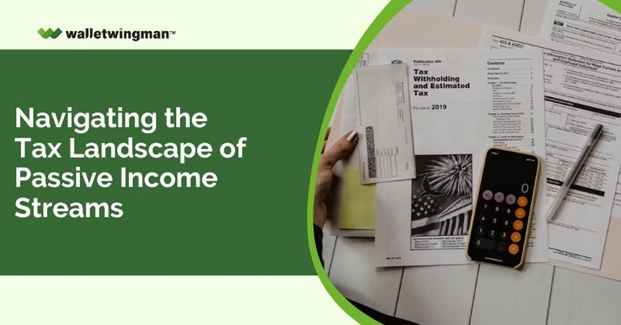Most employed people are familiar with the concept of income tax. You go to work, put in your best efforts, earn wages or salaries, and then surrender to the taxman his dues. Well, in many cases, the tax is remitted to the Internal Revenue Service (IRS) in advance, and the paycheck only reflects your take-home earnings. Read below as we delve into the tax landscape of passive income streams.
Income tax rates can vary considerably from one individual to another. The amount levied depends on factors like your job group and the taxation policies applicable to your type of business.
But income tax isn’t only levied on direct earnings. It can also be imposed on profits or interests accrued from indirect business undertakings. Such ventures constitute passive income, and the associated tax is known as passive income tax.
If you’re aspiring to establish a passive income stream, one of the questions probably lingering in your mind is – will I pay tax on my earnings, and if yes, how much will that be?
Well, this article shall address your concerns in detail.

What Is Passive Income?
Passive income is exactly what the term implies – income generated from indirect business undertakings.
Passive income is also commonly known as “unearned income,” ostensibly because it doesn’t require consistent action on your part to earn it. You only need to establish the venture, wait for it to pick up, and then sit back and passively cash out on your investment. The term is often contrasted with “earned income.” which denotes money generated from working as an employee of a company or yourself.
However, the phrase “unearned income” is now widely construed as a misnomer. That’s especially if you consider that all passive income ventures require a decent amount of capital investment. Therefore, it would be illogical to claim that the profits or interests accrued from these businesses aren’t deservedly earned.
What Is Active Income?
If you’re wondering what is active income, it’s the direct opposite of passive income. It denotes earnings that result from working as a direct employee.
Many people construct an active income concerning working for a third-party business or company. But as we’ve stated, the earnings might as well come from working on your own firm. Solopreneurs and sole proprietorships are noteworthy examples of active income earners whose money comes from businesses owned or managed by themselves.
In most economies, active income comes before passive income. People graduate from college or universities and seek employment in companies. They then save a portion of their earnings over a certain period and possibly supplement their savings with loans to establish passive income streams.
Depending on the stability of their newfound ventures, these people may then choose to resign from their regular jobs or pursue both undertakings concurrently.

Passive vs. Active Income – What’s The Difference?
Both passive and active income have their perks and drawbacks.
The main benefit of passive income is that the earnings do not require direct effort on your part. Once established, the business will continue to generate income as you invest your time in other equally-important aspects of your life.
Another reason to pursue passive income streams is that it can set you on the right path to financial independence. Many billionaires agree that it’s difficult to make meaningful wealth pursuing a single income stream. One of the workable wealth creation formulas is to spread your wings by establishing multiple passive income streams.
On the flip side, all passive income streams are considered business ventures. That means you must save significant capital to set them up.
When it comes to active income, the biggest advantage is that you require ZERO startup fees. Simply apply for the job and prove your worth before the interview panel.
Active income opportunities may also come with attractive fringe benefits. Depending on the nature of your engagement, you could be entitled to hefty housing, medical, and hardship allowance. Besides, there’s always the opportunity for a pay rise. That’s in sharp contrast to passive income, where interest rates may stagnate for a significant period or even take a dive during times of economic austerity.
However, the one drawback to active income is actually landing the job. It’s worse if you’re in developing economies with a highly competitive workforce.
Active income also means working at someone else’s pleasure. Unless you’re a civil servant, the future of your job will forever hang in the balance.
What Are Passive Income Examples?
There are dozens of passive income streams you could pursue. Noteworthy ones include;
Rental Properties
This entails purchasing a home, condo, or apartment complex or building one from scratch and then renting it out.
Unlike many passive income streams, dealing in rental properties may require a bit of effort in terms of collecting rent and ensuring the houses remain in good condition.
REITs
Real estate investment trusts (REITs) is a passive income opportunity for those looking for a hands-off way to invest in the real estate industry.
REITs basically own or manage real estate and allow other people to invest in the businesses.
Dividend Stocks
Dividend stocks is an arrangement where a company’s shareholders receive a portion of its profits. It’s one of the least-involving passive income streams.
Bond Ladders
A bond ladder is a low-risk passive income stream. It’s a portfolio whereby each bond matures at different periods.
Savings Account
Perhaps one of the most affordable passive income-generating ventures, a savings account is an arrangement where a bank account holds your money for a fixed duration.
You earn interest upon the maturity period, provided you do not prematurely access the funds.
Is Passive Income Taxable?
The Internal Revenue Service considers most passive incomes as true income. That means the profits or interests generated from such income streams are liable to taxation.
Passive income is generally taxed in the same way as active income. However, the amount of tax levied will depend on the income source and the earner’s financial situation.
Let’s have a look at the passive income taxes applicable to selected examples of passive income streams.
Rental Income
Rental income is the income generated from renting out properties. And while that definition may sound rather broad, it’s important to understand that numerous elements count as rental income and may be subjected to taxation accordingly.
Here are the various components of rental income;
- Advance rent payments
- Regular rent payments
- Security deposits that are non-refundable or partly refundable at the end of the lease period
- Property or services received in lieu of rent
- Lease cancellation and termination fees
- Tenant-paid owner expenses, which are expenses a tenant covers but which the landlord is legally responsible for
- Lease with option to buy, where the tenant has an option of purchasing the property
- Partial interest, where you co-own a property
The table below shows the IRS rental real estate taxes as at 2023;
| Tax Rate | Single Filers | Married Filing Jointly | Heads of Households |
| 10% | $0 to $11,000 | $0 to $22,000 | $0 to $15,700 |
| 12% | $11,000 to $44,725 | $22,000 to $89,450 | $15,700 to $59,850 |
| 22% | $44,725 to $95,375 | $89,450 to $190,750 | $59,850 to $95,350 |
| 24% | $95,375 to $182,100 | $190,750 to $364,200 | $95,350 to $182,100 |
| 32% | $182,100 to $231,250 | $364,200 to $462,500 | $182,100 to $231,250 |
| 35% | $231,250 to $578,125 | $462,500 to $693,750 | $231,250 to $578,100 |
| 37% | More than $578,125 | More than $693,750 | More than $578,100 |

Stock Dividends
The IRS generally taxes stock dividends. However, there are certain exceptions, such as dividends paid on stocks held in retirement accounts like a Roth IRA, traditional IRA, or 401 (k). These dividends aren’t taxed because most income or interest earned from such accounts are tax-exempt or tax-deferred.
Another exception is income acquired from stock dividends by people whose taxable income falls into the three lowest federal tax brackets. For instance, single filers are exempted from paying tax if their 2022 taxable income is $41 675 or less.
Dividend type is yet another key factor that determines the amount of stock dividend tax to pay. A qualified dividend is entitled to lower tax rates than a non-qualified or ordinary dividend.
Bearing all that in mind, the following is the 2023 passive income tax rate for unqualified dividend;
| Tax Rate | Single Filers | Married Filing Jointly | Heads of Households |
| 10% | Up to $11,000 | Up to $22,000 | Up to $15,700 |
| 12% | $11,000 to $44,725 | $22,000 to $89,450 | $15,700 to $59,850 |
| 22% | $44,725 to $95,375 | $89,450 to $190,750 | $59,850 to $95,350 |
| 24% | $95,375 to $182,100 | $190,750 to $364,200 | $95,350 to $182,100 |
| 32% | $182,100 to $231,250 | $364,200 to $462,500 | $182,100 to $231,250 |
| 35% | 231,250 to $578,125 | $462,500 to $693,750 | $231,250 to $578,100 |
| 37% | Over $578,125 | Over $693,750 | Over $578,100 |
Interest from Savings Account
Interest earned on savings accounts is also taxed at the same rate as regular income tax. This applies to interests accrued from high-yield savings, certificates of deposits, and money market accounts.
Ideally, these earnings are reported to the IRS on Form 1099-INT. The relevant financial institution where you maintain an interest-earning account then issues you with a separate 1099-INT.
Below are the prevailing savings account tax rates;
| Tax Rate | Single Filers | Married Filing Jointly | Heads of Households |
| 10% | Up to $11,000 | Up to $22,000 | Up to $15,700 |
| 12% | $11,001 to $44,725 | $22,001 to $89,450 | $15,701 to $59,850 |
| 22% | $44,726 to $95,375 | $89,451 to $190,750 | $59,851 to $95,350 |
| 24% | $95,376 to $182,100 | $190,751 to $364,200 | $95,351 to $182,100 |
| 32% | $182,101 to $231,250 | $364,201 to $462,500 | $182,101 to $231,250 |
| 35% | $231,251 to $578,100 (or to $346,875 for MFS) | $462,501 to $693,750 | $231,251 to $578,100 |
| 37% | More than $578,100 ($346,875 for MFS) | More than $693,750 | More than $578,100 |
Most importantly, it’s worth noting that the IRS only imposes taxes on the income earned and not the outstanding account balance.
Besides, the above percentages denote what the taxman levies on interests from savings accounts and not the interest rate offered by the financial institution holding your money.
Are All Passive Incomes Taxable?
Not all passive income streams are taxable. We’ve already highlighted special exemptions, such as incomes from Roth IRAs.
Other common passive incomes that are tax-exempt include;
- Tax-free municipal bonds
- Inheritance money
- Alimony and child support
- Disaster mitigation payments
- Disability payments
- Gifts
- Qualifying adoption reimbursements

Summary
Most passive incomes attract taxes just as active income. So, it’s prudent to understand your tax obligations if you’re considering setting up a passive income stream.


 A Detailed Guide to Taxation on Your Passive Income
A Detailed Guide to Taxation on Your Passive Income 